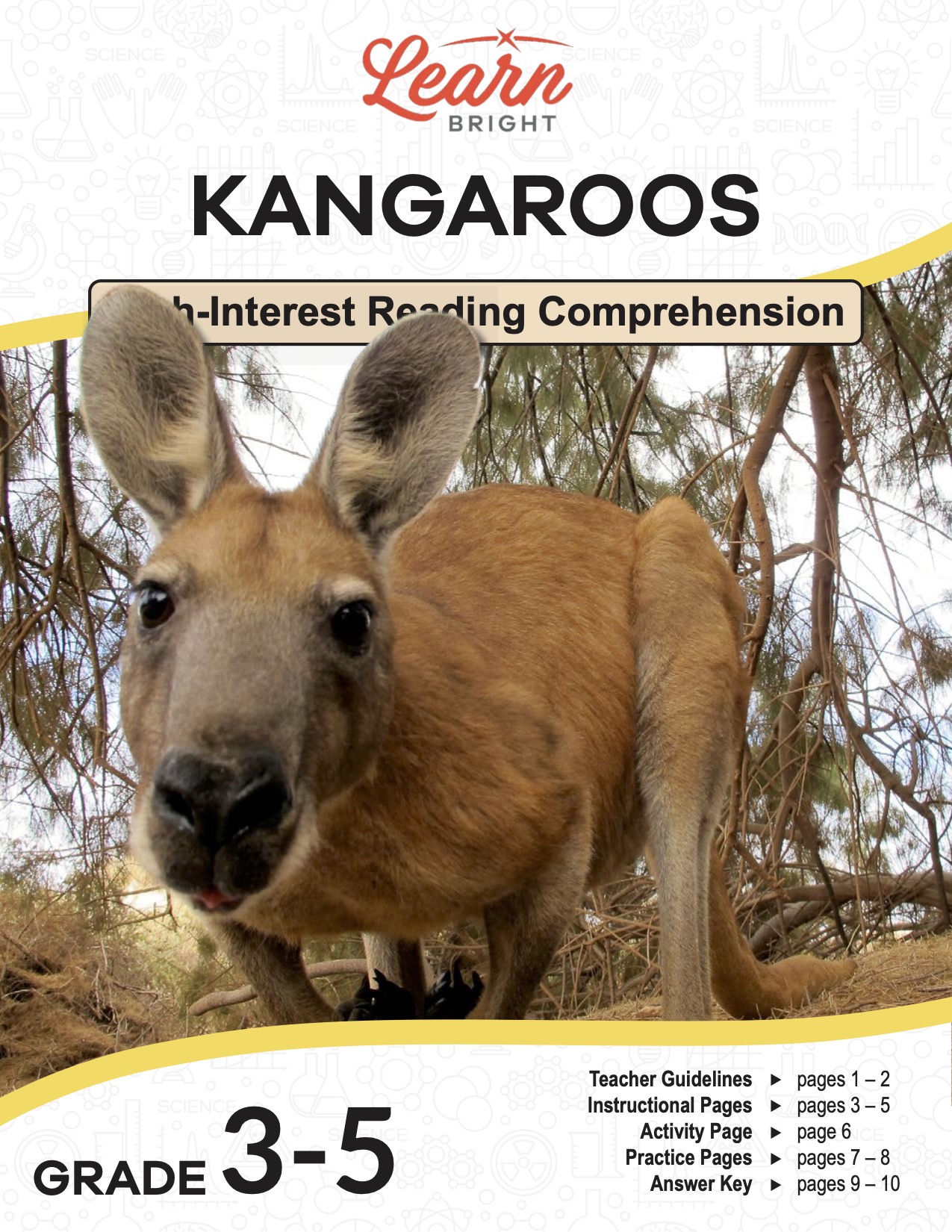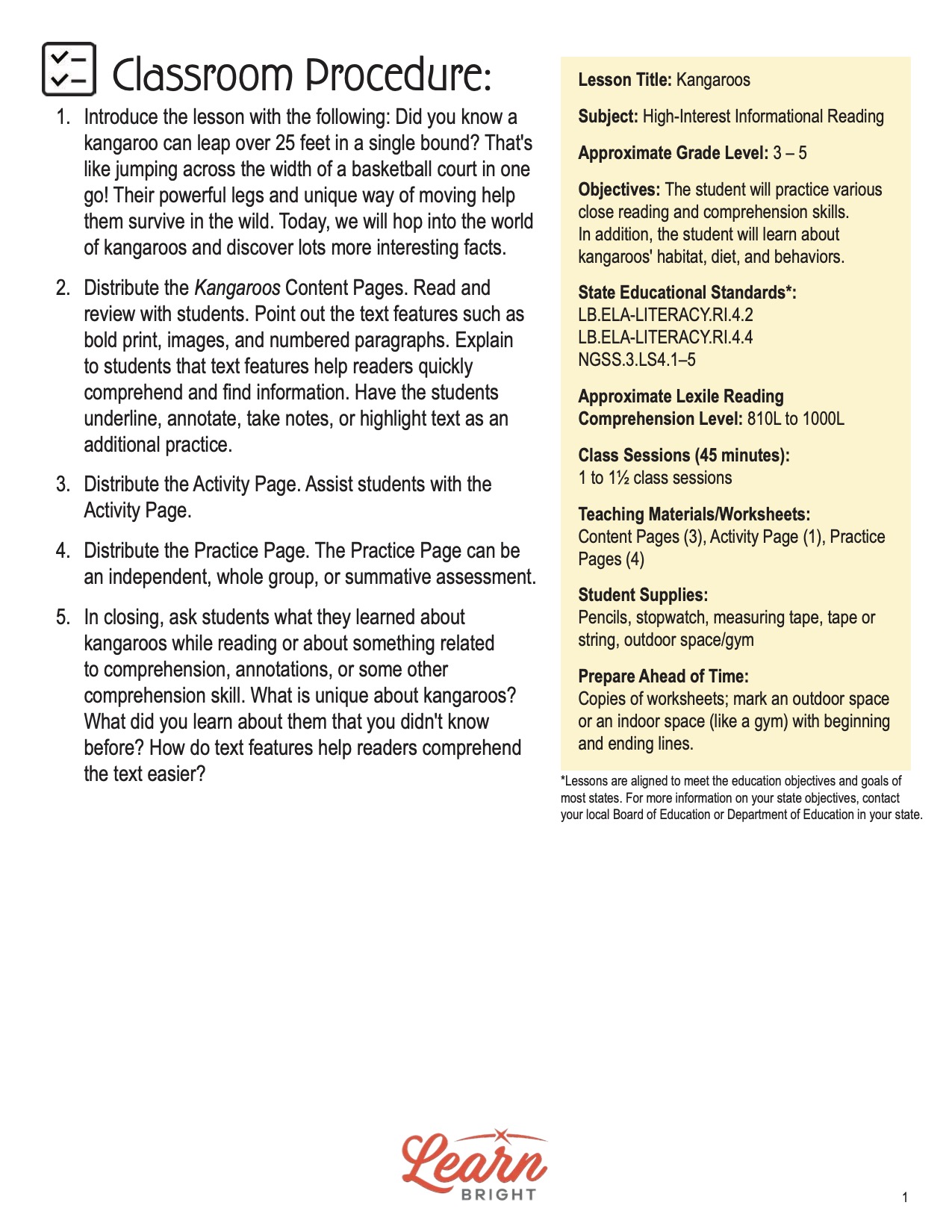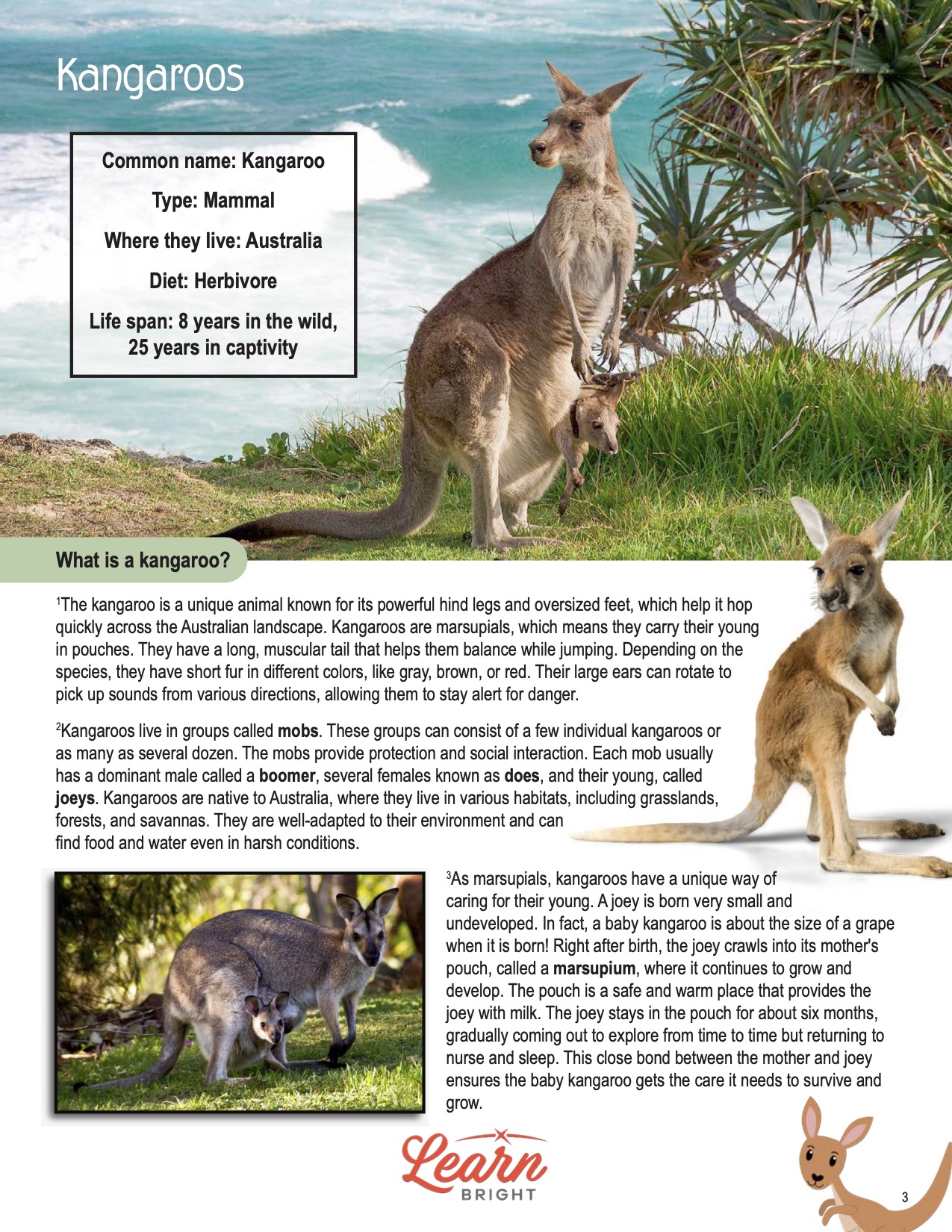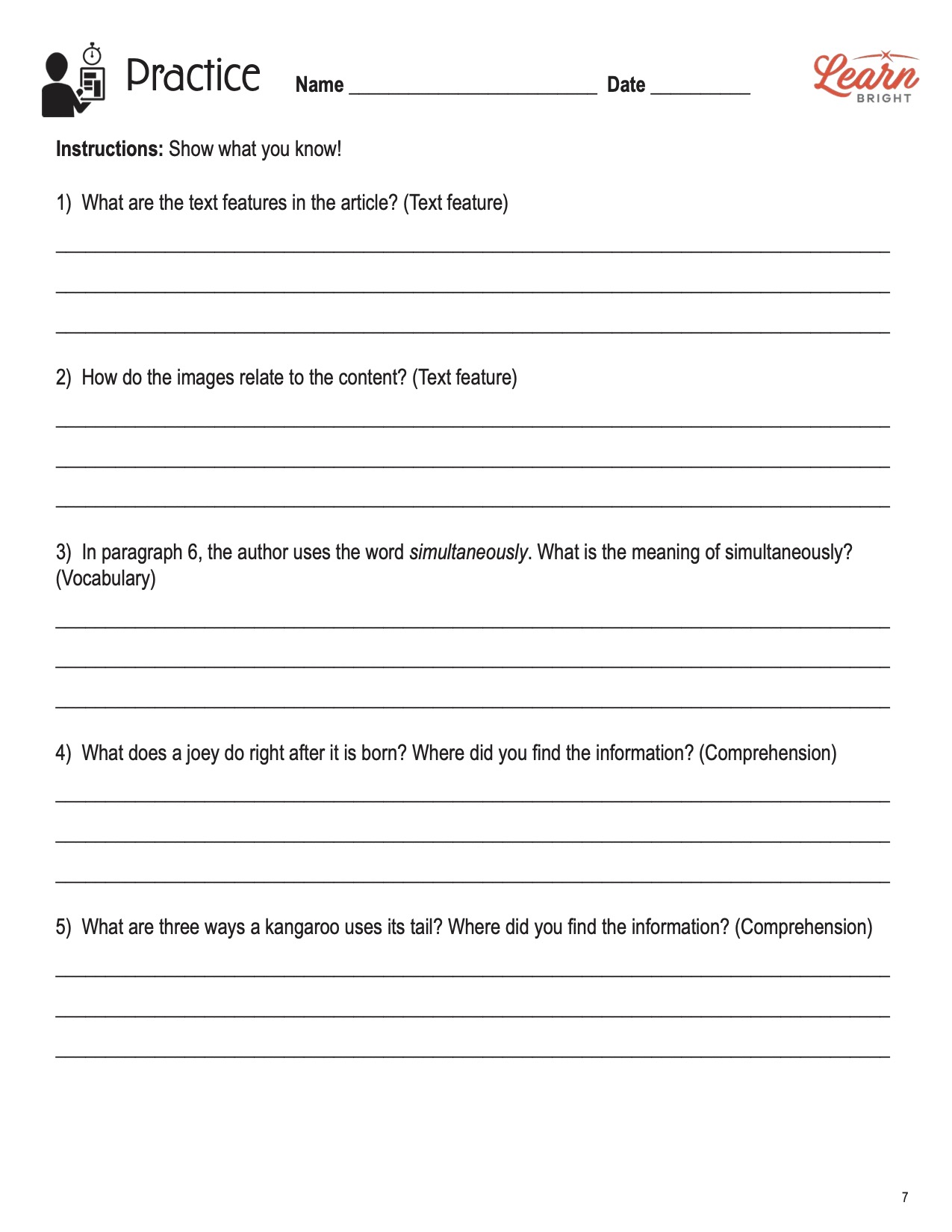Description
What our Kangaroos lesson plan includes
Lesson Objectives and Overview: Kangaroos is a high-interest reading comprehension lesson plan. As such, students will practice various close reading and comprehension skills. In addition, they will learn about the kangaroo’s habitat, diet, and behaviors. This lesson is for students in 3rd grade, 4th grade, and 5th grade.
Classroom Procedure
Every lesson plan provides you with a classroom procedure page that outlines a step-by-step guide to follow. You do not have to follow the guide exactly. The guide helps you organize the lesson and details when to hand out worksheets. It also lists information in the yellow box that you might find useful. You will find the lesson objectives, state standards, and number of class sessions the lesson should take to complete in this area. In addition, it describes the supplies you will need as well as what and how you need to prepare beforehand. The materials you’ll need for this lesson include a stopwatch, a measuring tape, and tape or string.
Teacher Notes
The teacher notes page provides an extra paragraph of information to help guide the lesson and remind you what to focus on. It explains that you can teach this lesson in a whole-class setting or as an independent, small-group activity. The blank lines on this page are available for you to write out thoughts and ideas you have as you prepare the lesson.
KANGAROOS LESSON PLAN CONTENT PAGES
What Are Kangaroos?
The Kangaroos lesson plan contains three content pages. It begins by providing a box of background information about this animal. They are mammals that are native only to Australia. Their diet consists of plants, so they are herbivores. In the wild, they live for about 8 years, but they can live for up to 25 years in captivity.
The kangaroo is a unique animal known for its powerful hind legs and oversized feet, which help it hop quickly across the Australian landscape. Kangaroos are marsupials, which means they carry their young in pouches. They have a long, muscular tail that helps them balance while jumping. Depending on the species, they have short fur in different colors, like gray, brown, or red. Their large ears can rotate to pick up sounds from various directions, allowing them to stay alert for danger.
Kangaroos live in groups called mobs. These groups can consist of a few individual kangaroos or as many as several dozen. The mobs provide protection and social interaction. Each mob usually has a dominant male called a boomer, several females known as does, and their young, called joeys. Kangaroos are native to Australia, where they live in various habitats, including grasslands, forests, and savannas. They are well-adapted to their environment and can find food and water even in harsh conditions.
As marsupials, kangaroos have a unique way of caring for their young. A joey is born very small and undeveloped. In fact, a baby kangaroo is about the size of a grape when it is born! Right after birth, the joey crawls into its mother’s pouch, called a marsupium, where it continues to grow and develop. The pouch is a safe and warm place that provides the joey with milk. The joey stays in the pouch for about six months, gradually coming out to explore from time to time but returning to nurse and sleep. This close bond between the mother and joey ensures the baby kangaroo gets the care it needs to survive and grow.
Diet of a Kangaroo
Kangaroos are herbivores, which means they only eat plants. They mainly feed on grasses, leaves, and shrubs. They cut and chew tough plants using their strong front incisors. Plus, they have a special stomach with multiple chambers that help them break down the fibrous plant material, similar to how cows digest their food. This multi-chambered stomach lets them get all the nutrients they need from their plant-based diet.
To get food, kangaroos spend a lot of time grazing, which means eating grass and other plants. They must find food sources that provide enough nutrients and water to keep them healthy. In the wild, kangaroos can travel long distances to find fresh grazing areas, especially during dry seasons when food is scarce. Their powerful legs help them cover large areas quickly in search of the best plants to eat.
Other Interesting Facts
Speaking of powerful legs, kangaroos have an incredible jumping ability. They can leap great distances, sometimes up to 25 feet in a single bound! Their powerful hind legs and oversized feet are like springs that propel them forward. This distinctive way of moving helps them travel quickly and efficiently across the vast Australian landscape where they live. Their long tail also keeps them balanced while jumping and can support them when they sit. When they need to move slowly, like when eating grass, they use their back legs one at a time to walk. But when they want to go fast, both back legs move simultaneously, pushing them forward in big hops.
Kangaroos live in dry environments, so they use certain strategies to conserve water and remain hydrated. They can go for long periods without drinking water because they get moisture from the plants they eat. In addition, they stay active primarily during the cooler parts of the day, such as the early morning and late afternoon, to avoid losing too much water in the heat.
Did you know kangaroos can swim, too? When they swim, their legs work differently than on land. In the water, they use their back legs separately, moving them in a paddle motion to help them glide forward. They use their tail to steer them in the water. So, kangaroo legs are perfectly adapted on land or water to help them get around!
Why They Are Important
Kangaroos are essential for the environment because they help keep the ecosystem balanced. As herbivores, they help control plant growth and prevent any one type of plant from taking over an area. This grazing also helps create a healthy animal habitat by maintaining open spaces where other species can live and find food. Additionally, when kangaroos move around, they spread seeds through their droppings, which helps new plants grow and keeps the ecosystem diverse and thriving.
These amazing marsupials are not currently endangered, which means there are still plenty of them in the wild. People work hard to protect them by conserving their natural habitats and creating protected areas where they can live safely. Caring for the environment and supporting conservation efforts can help ensure that kangaroos continue to live and thrive in their Australian ecosystem.
KANGAROOS LESSON PLAN WORKSHEETS
The Kangaroos lesson plan includes two worksheets: an activity worksheet and a practice worksheet. Each one will help students solidify their grasp of the material they learned throughout the lesson. You can refer to the classroom procedure guidelines to know when to hand out each worksheet.
KANGAROO HOP ACTIVITY WORKSHEET
For this activity, students will practice their hopping skills! Set up by using tape or string to make a 25-foot line. Students will squat down low and spring up and forward to hop as far as possible. Use a tape measure to measure the distance they hop down the line. Have students time themselves to see how quickly they can get to the end.
REVIEW PRACTICE WORKSHEET
The practice worksheet requires students to answer a series of 10 questions. These questions all relate to the content pages, so students will need to refer to them often for the answers. In addition, each question provides which reading tool the question corresponds to, such as text feature, vocabulary, or comprehension.
Worksheet Answer Keys
At the end of the lesson plan document is an answer key for the practice worksheet. The correct answers are all in red to make it easier for you to compare them with students’ responses. If you choose to administer the lesson pages to your students via PDF, you will need to save a new file that omits these pages. Otherwise, you can simply print out the applicable pages and keep these as reference for yourself when grading assignments.










